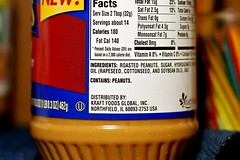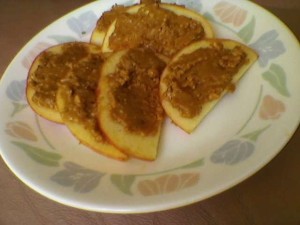Homemade peanut butter without anti-nutrients

Are you looking for pure peanut butter without additives here in Israel? Have you gone through the grocery store aisles only to be disappointed by the various brands of peanut butter all with added sugar, oils, and other ingredients? They may be cheap, but you know they’re not healthy. The only brand of pure unadulterated peanut butter in Israel, it seems, is B&D. Since it is only sold as a creamy peanut butter, people who miss chunky peanut butter as much as my husband does, often purchase raw peanuts, chop them up, and add them to B&D’s finest. However, if you are open to new ideas and more healthful opportunities, then you can make your own peanut butter.
About a month ago I came across a great recipe for natural peanut butter without any anti-nutrients. I am always glad when I can feed my family pure wholesome foods and this recipe fit the bill. I was anxious to try it and bought the peanuts at my first opportunity. I was not disappointed.
As I’ve discussed in an earlier post, nuts, seeds, legumes, and grains contain anti-nutrients in the form of enzyme inhibitors, which can neutralize the enzymes in the digestive tract, and phytates which bind minerals, making them unavailable to the body. Soaking the peanuts overnight in warm, salted, and filtered water will inactivate these anti-nutrients making the peanuts a much healthier product. (Peanuts in general are a rather nutritious legume and surprisingly, contain resveratrol and coenzyme Q10 in addition to protein, a host of nutrients, and antioxidants.)

The recipe that I followed is from the now-defunct blog Purelifebondi (Bondi is a suburb of Sydney, Australia) which calls for the following (comments are mine):
♦ 500 grams (1 lb.) of raw, shelled peanuts
[Do not buy salted or roasted nuts. If you can find organic, that’s even better.]
♦ Filtered water
♦ 2 pinches of Himalayan salt
[This pink salt is full of minerals. You can find it in health food stores.]
♦ 4 Tbsp coconut oil
♦ Optional tsp honey [I left it out]
Soak peanuts for 7-12 hours. Rinse and drain. Spread peanuts on a baking tray and pop in oven set at 100°C (210.00ºF).
Dry at this temperature for an hour or so and then increase the temperature to 150°C (300.00ºF). Keep turning the nuts and make sure they don’t burn.
When the peanuts are golden in color, crunchy to eat and the smell of peanuts fills your house, remove from the oven. Once the peanuts are cool enough to touch, place them into the food processor with coconut oil and salt.
Blend until the peanuts resemble bread crumbs. Transfer the peanut pieces to a blender and blend on low. This step will take about 10 minutes as you will have to keep stirring the peanuts. Eventually the peanuts will resemble a crunchy peanut butter. Continue blending until you reach the desired consistency. Add honey for a sweeter taste.
If you have a Vitamix there is no need for the two steps.
Unfortunately, I only had a hand blender which didn’t allow me to get the smoother consistency that I would have liked, and it overheated in the process. Nevertheless my family devoured this very chunky homemade peanut butter. There’s only a drop left.

I am now in the market for a blender.
Great post! FYI- B&D just came out with a crunchy peanut butter. http://www.bnd.co.il
Thanks for commenting. A friend emailed me yesterday to tell me about their crunchy peanut butter also. I asked her for the ingredients and unfortunately it is not pure like the creamy peanut butter as it includes sugar, vegetable oil, stabilizers, and salt. The salt I can accept, but not the other ingredients which are unnecessary and not healthy.
Interesting- I wonder why they strayed from their generally clean labeling…
Yes, it’s a shame. I think they could have gotten a lot more business and made a lot of people happy in the process if they would have kept it additive free.
Thanks Caryn, I’ve been making my own Peanut butter for years- I just don’t use Himalayan sat- I use sea salt- but am willing to try it! 🙂
Both Himalayan salt and good quality sea salt are good but each have somewhat different benefits and properties. Some interesting information about each type can be found here: http://www.natural-salt-lamps.com/salt.html and here: http://juicing-for-health.com/sea-salt-health-benefits.html.